Axolotls are the ultimate low-maintenance pet. With minimal space requirements and very basic care instructions, these adorable little salamanders can bring joy to first-time owners across the globe. Even they don’t need much investment for their tanks.
We’re clear on that front, but one question remains on the minds of many novice Keepers: Can I put sand in my axolotl’s tank? Yes, you can. But you should be careful about what kind of sand you’re putting. In my opinion, play sand, aquarium sand or silica sand is the best for axolotl.
Here in this short blog, you will have an in-depth idea about the entire ordeal.
What kind of sand can you use for axolotls?
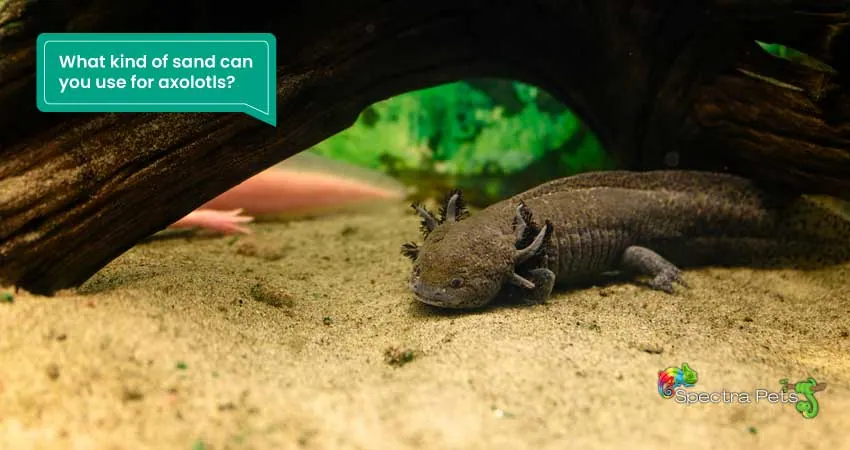
Axolotls are sensitive animals that get easily harmed if the substrate is not according to their standard. Sand is a top-notch option for axolotl tanks substrate.
The first rule for axolotl sand is that it has to be fine natural sand. You will find versatile sand that can work really well for an axolotl tank and these are the following…
- Play sand
- Aquarium sand with no added dyes
- Silica sand
- Aquarium filter sand
- Stoney river sand
Which sands are inappropriate for your axolotl tank?
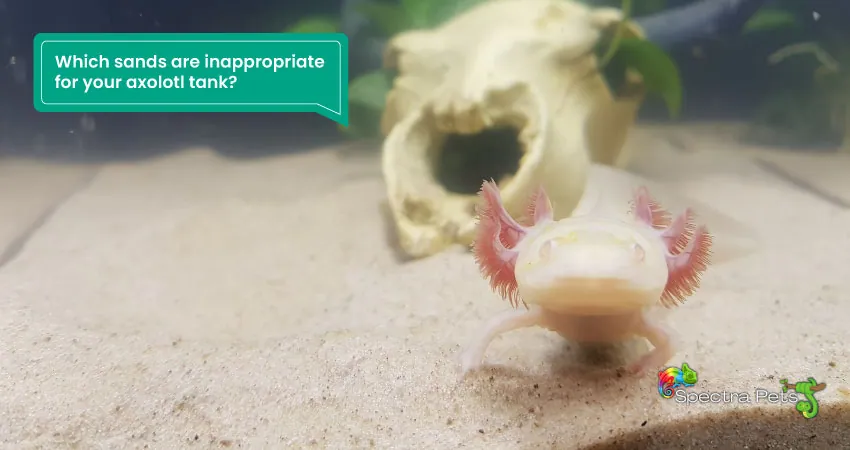
Due to chemical composition, harmful substances, and the sharpness or high coarseness, some sands are not suitable for an axolotl tank. Let’s have a look at those sands…
- Colored sand – This can turn the water cloudy and increase toxic levels
- Marine sand – Rich in calcium carbonate
- Quartz sand
- Construction sand – Very sharp
- Sparkly sand
- Sand that contains magnetite
- Reptile tank sand
- Calcium carbonate sand ( Spike the pH level of water)
Is play sand the best sand for an axolotl tank?
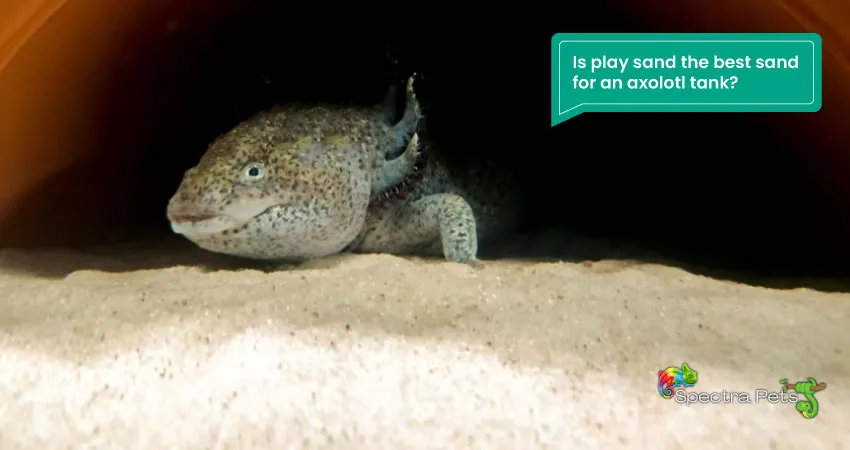
When it comes to the most friendly substrate sand for the axolotl, play sand is number one.
Compared to the aquarium sand and the reptile sand the play sand is finer. As a result, you should not be concerned about axolotls having skin damage. Even in terms of cost, play sand is much cheaper compared to other types of sand materials.
Imagine your axolotl is getting camouflaged due to the color of the sand that’s probably the last thing you want. Play sand ensures that your axolotl’s color looks more bright and it stands out inside the tank clearly.
How to prepare and add play sand to your axolotl tank?
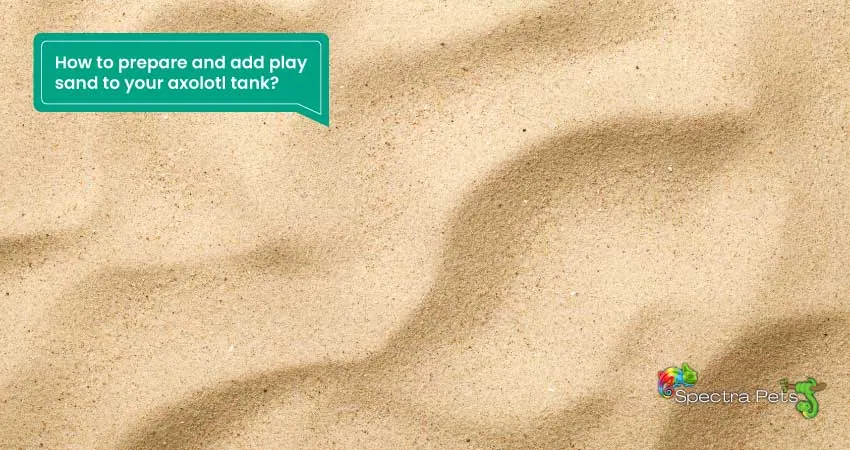
Play sand is considered the safest option for an axolotl tank. But you must go through some washing process to make it perfect for placing into the tank. So here is how it works…
- Rinse the sand thoroughly using clean water. You must avoid using tape water. For cleaning the sand filter water, dechlorinated water or spring water are best. Ensure there is no debris left in the sand.
- Now keep the sand in a bucket full of water. Leave it to soak for 24 hours. It will help to remove any hidden dust and impurities.
- Slowly place the sand substrate into the axolotl tank. And the process of adding sand is complete.
What are the pros and cons of using sand as an axolotl substrate?
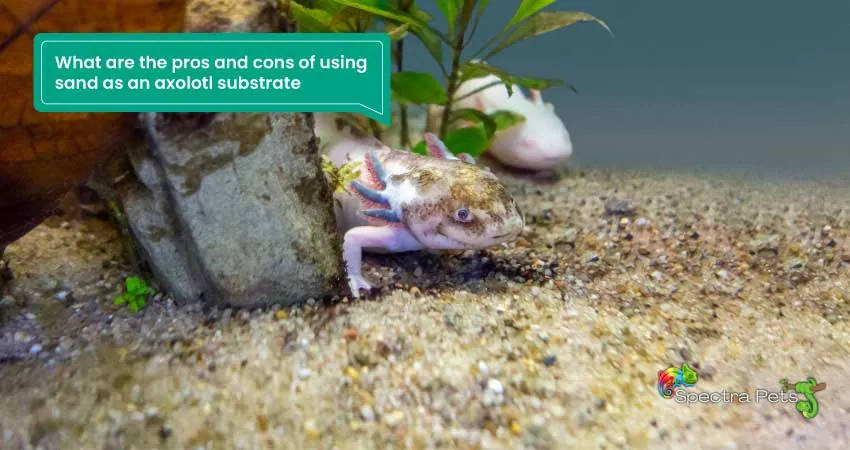
Like any other material, sand has its dark and bright side as an axolotl tank substrate. In the following, you will see both pros and cons of sand axolotl substrate…
Pros:
- Sand substrate is perfect for growing varieties of axolotl tanks that enhance the beauty of the aquarium
- Helps to grow beneficial bacteria inside the tank
- Along with the aesthetic looks, the sand layer gives a more natural look which slightly adds to the natural habitats vibes
- Unlike other substrates, sand does not lead to impaction or indigestion of axolotl
- The Sandy layer serves as a soft & comfy surface for the smooth stress-free movement of your beloved axolotl
Cons:
- Cleaning is a bit harder compared to the rocky or bare surface
- Sand can cause cloudy water
- Bulk amounts of sand eating can cause health issues in axolotl
Faq
Can baby axolotls have sand in their tank?
You can keep sand as the substrate layer in the baby axolotls tank. Even if they accidentally swallow a bit of sand, eventually it will get digested soon. But for best health, it’s not recommended and you can keep them with a bare surface.
How deep should the sand be for an axolotl tank?
A 1-2’’ depth sand layer would be an ample amount for the axolotl tank. All you have to do is to stir the sand every week. It will reduce the formation of any kind of gas or unwanted anaerobic bacteria.
Can you use play sand for the axolotl tank?
Yes, play sand is the optimum choice for your axolotl tank and it serves as the safest substrate for axolotl.
Is black sand good for axolotl tanks?
Some say black sand is good, some say bad for axolotl. The main thing is if the color is not added and it’s real black sand then there is not any health issue as long as their grain size is fine.
Is Crayola play sand safe for axolotls?
No, Crayola play sand is mostly coated with acrylic so it’s not a safe substrate for axolotls.
Is quikrete play sand safe for axolotls?
Though a bit pricey but quikrete play sand is fully safe for axolotls.
Do axolotls like bare-bottom tanks?
No, bare-bottom tanks are not good for axolotls, especially for adult and juvenile ones. Because they have to walk on the substrate layer and a hard bare bottom will put extreme stress on the fragile toes of the axolotl. However, the bare bottom works fine for the baby or newborn axolotl.
Is gravel or sand better for axolotls?
Between gravel and sand, undoubtedly sand is the better option for axolotl. As it gives more safety to axolotls’ easily permeable skin, and their smooth movement inside the aquarium.
Can I use beach sand for the axolotl tank?
Unfortunately, you can’t use beach sand though they are free. These sand are loaded with calcium which can increase the pH level inside the axolotl tank. Moreover, they can also be a carrier for parasites to enter the tank.
Parting Words
All in all, can axolotl have sand in their tanks? Yes. If you’re looking for an easy and cheap way to set up your tank, go ahead and add some sand. But definitely, do your research about which sand you’re getting because not all of them are beneficial for your Axolotl. All the best.
